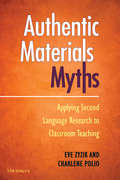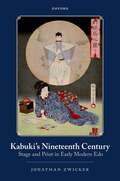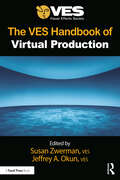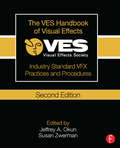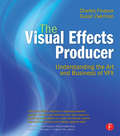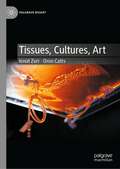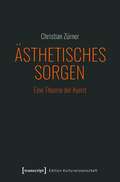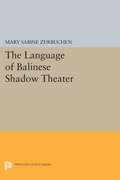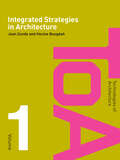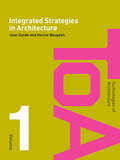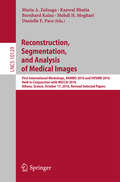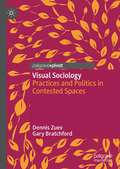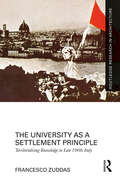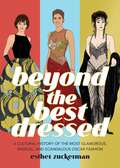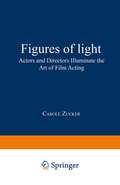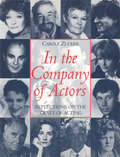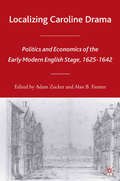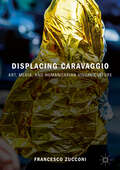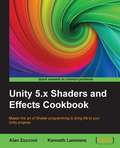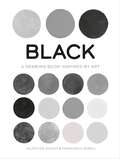- Table View
- List View
Authentic Materials Myths: Applying Second Language Research to Classroom Teaching
by Eve Zyzik Charlene PolioThe use of authentic materials in language classrooms is sometimes discussed as a reliable way to expose students to the target language, but there is also disagreement regarding what kinds of authentic materials should be used, when they should be used, and how much of the curriculum should revolve around them. This volume in the Myths series explores the research related to the use of authentic materials and the ways that authentic materials may be used successfully in the classroom. Like others in the Myths series, this book combines research with good pedagogical practices. The myths examined in this book are: Authentic texts are inaccessible to beginners. Authentic texts cannot be used to teach grammar. Shorter texts are more beneficial for language learners. Activating background knowledge or making a word list is sufficient to prepare students for authentic texts. Authentic texts can be used to teach only listening and reading. Modifying or simplifying authentic texts always helps language learners. For learners to benefit from using authentic texts, the associated tasks must also be authentic. The Epilogue explores the challenges of using authentic texts in the classroom and calls for more research.
Kabuki's Nineteenth Century: Stage and Print in Early Modern Edo
by Prof Jonathan ZwickerKabuki's Nineteenth Century examines the theater culture of nineteenth-century Japan from the perspective of the history and materiality of the book, the nature of reception, and the making and making use of images. The aim of this book is to rediscover the kabuki theater of nineteenth-century Japan by shifting our critical focus from performance to print and the public sphere, and thus embedding theater history within the larger world of printed matter by means of which theatricality circulated beyond the stage and through which performance was most often consumed. Fundamental to Kabuki's Nineteenth Century is a reconsideration of the nature of the printed archive itself. The book argues that the archive of printed material related to the theater in nineteenth-century Japan (playbills, actor critiques, theater guides, maps, actor prints, calendars, and broadsheets) is something more than—and more complicated than—a set of materials out of which we might reconstitute the always transient event of performance. Rather, the archive constitutes an object of inquiry unto itself, an object that reveals as much about the interrelations between and among various printed media and genres circulating beyond the confines of the theater as it does about what happened on stage. Even as we use these materials to examine the history of performance, a series of different questions might be asked: what can the production, consumption, and collecting of this enormous body of printed matter tell us about such problems as the role of print in everyday life, the construction of specialized knowledges, and the manner in which a culture archives itself?
Kabuki's Nineteenth Century: Stage and Print in Early Modern Edo
by Jonathan E. ZwickerKabuki's Nineteenth Century examines the theater culture of nineteenth-century Japan from the perspective of the history and materiality of the book, the nature of reception, and the making and making use of images. The aim of this book is to rediscover the kabuki theater of nineteenth-century Japan by shifting our critical focus from performance to print and the public sphere, and thus embedding theater history within the larger world of printed matter by means of which theatricality circulated beyond the stage and through which performance was most often consumed. Fundamental to Kabuki's Nineteenth Century is a reconsideration of the nature of the printed archive itself. The book argues that the archive of printed material related to the theater in nineteenth-century Japan (playbills, actor critiques, theater guides, maps, actor prints, calendars, and broadsheets) is something more than—and more complicated than—a set of materials out of which we might reconstitute the always transient event of performance. Rather, the archive constitutes an object of inquiry unto itself, an object that reveals as much about the interrelations between and among various printed media and genres circulating beyond the confines of the theater as it does about what happened on stage. Even as we use these materials to examine the history of performance, a series of different questions might be asked: what can the production, consumption, and collecting of this enormous body of printed matter tell us about such problems as the role of print in everyday life, the construction of specialized knowledges, and the manner in which a culture archives itself?
The VES Handbook of Virtual Production
by Susan Zwerman Jeffrey A. Okun Susan Thurmond O’NealThe VES Handbook of Virtual Production is a comprehensive guide to everything about virtual production available today – from pre-production to digital character creation, building a stage, choosing LED panels, setting up Volume Control, in-camera compositing of live action and CG elements, Virtual Art Departments, Virtual Previs and scouting, best practices and much more.Current and forward-looking, this book covers everything one may need to know to execute a successful virtual production project – including when it is best to use virtual production and when it is not. More than 80 industry leaders in all fields of virtual production share their knowledge, experiences, techniques, and best practices. The text also features charts, technical drawings, color images, and an extensive glossary of virtual production terms.The VES Handbook of Virtual Production is a vital resource for anyone wishing to gain essential knowledge in all aspects of virtual production. This is a must-have book for both aspiring and veteran professionals. It has been carefully compiled by the editors of The VES Handbook of Visual Effects.
The VES Handbook of Visual Effects: Industry Standard VFX Practices and Procedures
by Susan Zwerman Jeffrey A. OkunWisdom from the best and the brightest in the industry, this visual effects bible belongs on the shelf of anyone working in or aspiring to work in VFX. The book covers techniques and solutions all VFX artists/producers/supervisors need to know, from breaking down a script and initial bidding, to digital character creation and compositing of both live-action and CG elements. In-depth lessons on stereoscopic moviemaking, color management and digital intermediates are included, as well as chapters on interactive games and full animation authored by artists from EA and Dreamworks respectively. From predproduction to acquisition to postproduction, every aspect of the VFX production workflow is given prominent coverage. VFX legends such as John Knoll, Mike Fink, and John Erland provide you with invaluable insight and lessons from the set, equipping you with everything you need to know about the entire visual effects workflow. Simply a must-have book for anyone working in or wanting to work in the VFX industry.
The Visual Effects Producer: Understanding the Art and Business of VFX
by Susan Zwerman Charles FinanceFirst published in 2010. Routledge is an imprint of Taylor & Francis, an informa company.
The Visual Effects Producer: Understanding the Art and Business of VFX
by Susan Zwerman Charles FinanceFirst published in 2010. Routledge is an imprint of Taylor & Francis, an informa company.
Tissues, Cultures, Art (Palgrave BioArt)
by Ionat Zurr Oron CattsTissues, Cultures, Art narrates the twenty-five years of collaborative and sometimes provocative artistic practice and scholarly thought of Catts & Zurr, who pioneered the use of regenerative biology techniques to create Semi-Living art using living cells, tissues, and technological surrogate bodies. Through hands-on work in biological laboratories, the authors researched concepts such as partial-life and DNA-Chauvinism and explored the fantasies of living in a technologically mediated victimless utopia. The authors delve into life’s resistance to reductionism, systemisation and control, asking whether there is something unique to life without the need to resort to metaphysics. Their practices reach beyond the confines of art and are often cited as precursors to the cellular agriculture and biofabrication industries. Through a hybrid of personal reflections, poetics, and anecdotes with a more rigorous, scholarly approach – all illustrated with artworks - the authors present a critical view on the use of life as a raw material for human manipulation.
Ästhetisches Sorgen: Eine Theorie der Kunst (Edition Kulturwissenschaft #241)
by Christian ZürnerÄsthetik reflektiert Kunst, kaum aber deren konkrete Verwendungsformen. Um zu verstehen, was Kunst ist, muss sie jedoch als spezifische Situationen konstituierende besondere Praxis untersucht werden. Kunst ist kein Erkennen oder Erfahren, sondern strategisches Tun: Als (feierliches) ästhetisches Sorgen kultiviert sie in öffentlichen wie privaten Kontexten eine Praxis existenziellen kultischen Sorgens. Christian Zürner hinterfragt ästhetische Topoi wie Autonomie und (Zweck-)Freiheit angesichts solch immanenter Notwendigkeit ebenso wie normative philosophische Zuschreibungen. Kunst bedeutet keinen souveränen Überschuss, sondern lebt vom Drang, menschliche Existenz in einer unheimlichen Welt überhaupt erst einzurichten.
The Language of Balinese Shadow Theater
by Mary Sabine ZurbuchenBali's shadow puppet theater, like others in Southeast Asia, is a complex tradition with many conventions that puzzle Western observers. Mary Zurbuchen demonstrates how the linguistic codes of this rich art form mediate between social groups, cultural influences, historical periods, and conceptual schemes.Originally published in 1987.The Princeton Legacy Library uses the latest print-on-demand technology to again make available previously out-of-print books from the distinguished backlist of Princeton University Press. These editions preserve the original texts of these important books while presenting them in durable paperback and hardcover editions. The goal of the Princeton Legacy Library is to vastly increase access to the rich scholarly heritage found in the thousands of books published by Princeton University Press since its founding in 1905.
Integrated Strategies in Architecture
by Joan Zunde Hocine BougdahThis key text presents students with a holistic view of the building design process, bridging the gap between the theory and practice of constructing and assembling buildings. Integrated Strategies in Architecture encourages and enables students to gain a sound understanding of the purpose of buildings, the specialisms that contribute and the available technology. Zunde and Bougdah thoroughly introduce and expose the concepts and technologies that underlie the design process, setting current design in context as part of an evolutionary process, exemplified through historic and contemporary models, and emphasizing the importance of applying a broad variety of technologies in the creation of successful buildings. Topics covered include: space planning, colour theory, communication, management, aesthetics, structures and environmental control. This essential text will greatly assist students of architecture and its technology, construction management and building surveying as well as practitioners as they strive to build better buildings.
Integrated Strategies in Architecture
by Joan Zunde Hocine BougdahThis key text presents students with a holistic view of the building design process, bridging the gap between the theory and practice of constructing and assembling buildings. Integrated Strategies in Architecture encourages and enables students to gain a sound understanding of the purpose of buildings, the specialisms that contribute and the available technology. Zunde and Bougdah thoroughly introduce and expose the concepts and technologies that underlie the design process, setting current design in context as part of an evolutionary process, exemplified through historic and contemporary models, and emphasizing the importance of applying a broad variety of technologies in the creation of successful buildings. Topics covered include: space planning, colour theory, communication, management, aesthetics, structures and environmental control. This essential text will greatly assist students of architecture and its technology, construction management and building surveying as well as practitioners as they strive to build better buildings.
Reconstruction, Segmentation, and Analysis of Medical Images: First International Workshops, RAMBO 2016 and HVSMR 2016, Held in Conjunction with MICCAI 2016, Athens, Greece, October 17, 2016, Revised Selected Papers (Lecture Notes in Computer Science #10129)
by Maria A. Zuluaga Kanwal Bhatia Bernhard Kainz Mehdi H. Moghari Danielle F. PaceThis book constitutes the refereed proceedings of two workshops held at the 19th International Conference on Medical Image Computing and Computer-Assisted Intervention, MICCAI 2016, in Athens, Greece, in October 2016: the First International Workshop on Reconstruction and Analysis of Moving Body Organs, RAMBO 2016, and the First International Workshop on Whole-Heart and Great Vessel Segmentation from 3D Cardiovascular MRI in Congenital Heart Disease, HVSMR 2016. The 17 revised regular papers presented in this book were carefully reviewed and selected from a total of 21 submissions. The papers cover following topics: Registration; Reconstruction; Deep learning for heart segmentation; Discrete optimization and probabilistic intensity modeling; Atlas-based strategies; Random forests.
Useware-Engineering für technische Systeme (VDI-Buch)
by Detlef ZühlkeMit dem Begriff Useware ist eine Fokussierung der Technikgestaltung auf menschliche Fähigkeiten und Bedürfnisse an der Mensch-Maschine-Schnittstelle verbunden. Das Buch hilft Entwicklern in der Industrie und Forschung mit praktisch orientierten Beispielen für Gestaltungslösungen. Eine kurze Erläuterung der menschlichen Fähigkeiten erhöht das Verständnis für die Vorgehensweise bei der Gestaltung komplexer Useware-Systeme, die detailliert dargestellt wird.
Visual Sociology: Practices and Politics in Contested Spaces (Routledge Advances In Sociology Ser. #91)
by Dennis Zuev Gary BratchfordThis book provides a user-friendly guide to the expanding scope of visual sociology, through a discussion of a broad range of visual material, and reflections on how such material can be studied sociologically. The chapters draw on specific case-study examples that examine the complexity of the hyper-visual social world we live in, exploring three domains of the ‘relational image’: the urban, social media, and the aerial. Zuev and Bratchford tackle issues such as visual politics and surveillance, practices of visual production and visibility, analysing the changing nature of the visual. They review a range of methods which can be used by researchers in the social sciences, utilising new media and their visual interfaces, while also assessing the changing nature of visuality. This concise overview will be of use to students and researchers aiming to adopt visual methods and theories in their own subject areas such as sociology, visual culture and related courses in photography, new-media and visual studies.
The University as a Settlement Principle: Territorialising Knowledge in Late 1960s Italy (Routledge Research in Architecture)
by Francesco ZuddasThe 1960s and the 1970s marked a generational shift in architectural discourse at a time when the revolts inside universities condemned the academic institution as a major force behind the perpetuation of a controlling society. Focusing on the crisis and reform of higher education in Italy, The University as a Settlement Principle investigates how university design became a lens for architects to interpret a complex historical moment that was marked by the construction of an unprecedented number of new campuses worldwide. Implicitly drawing parallels with the contemporary condition of the university under a regime of knowledge commodification, it reviews the vision proposed by architects such as Vittorio Gregotti, Giuseppe Samonà, Archizoom, Giancarlo De Carlo, and Guido Canella, among others, to challenge the university as a bureaucratic and self-contained entity, and defend, instead, the role of higher education as an agent for restructuring vast territories. Through their projects, the book discusses a most fertile and heroic moment of Italian architectural discourse and argues for a reconsideration of architecture’s obligation to question the status quo. This work will be of interest to postgraduate researchers and academics in architectural theory and history, campus design, planning theory, and history.
The University as a Settlement Principle: Territorialising Knowledge in Late 1960s Italy (Routledge Research in Architecture)
by Francesco ZuddasThe 1960s and the 1970s marked a generational shift in architectural discourse at a time when the revolts inside universities condemned the academic institution as a major force behind the perpetuation of a controlling society. Focusing on the crisis and reform of higher education in Italy, The University as a Settlement Principle investigates how university design became a lens for architects to interpret a complex historical moment that was marked by the construction of an unprecedented number of new campuses worldwide. Implicitly drawing parallels with the contemporary condition of the university under a regime of knowledge commodification, it reviews the vision proposed by architects such as Vittorio Gregotti, Giuseppe Samonà, Archizoom, Giancarlo De Carlo, and Guido Canella, among others, to challenge the university as a bureaucratic and self-contained entity, and defend, instead, the role of higher education as an agent for restructuring vast territories. Through their projects, the book discusses a most fertile and heroic moment of Italian architectural discourse and argues for a reconsideration of architecture’s obligation to question the status quo. This work will be of interest to postgraduate researchers and academics in architectural theory and history, campus design, planning theory, and history.
Beyond the Best Dressed: A Cultural History of the Most Glamorous, Radical, and Scandalous Oscar Fashion
by Esther ZuckermanExplore two dozen of the most glamorous, scandalous, and history-making Oscar looks in Beyond the Best Dressed, film and culture critic Esther Zuckerman's personality-filled romp through red carpet fashion, complete with original fashion drawings from illustrator Montana Forbes. From the show-stoppingly elegant (Halle Berry winning the award for Monster&’s Ball in a breathtaking Elie Saab) to the decidedly kooky (Adam Rippon in a formal harness), the Academy Awards Telecast is one of the few nights of the year devoted entirely to glamor (in all its forms). Even in the age of streaming, millions upon millions of people sit down at the same time, turn on their televisions, and watch celebrities strut down the red carpet (and, sure, win some awards). Now fans can relive the glamor, drama, and lasting legacy of some of the most influential outfits from more than ninety years of the Oscar in Beyond the Best Dressed: A Cultural History of the Most Glamorous, Radical, and Scandalous Oscar Fashion. In twenty-five essays, culture writer Esther Zuckerman explores the iconic fashion choices that made history on the most elegant stage of all, and analyzes the cultural impact of wardrobe decisions both absurd and wonderful. Beginning with Hattie McDaniel&’s historic and trendsetting turquoise gown in 1940 (worn at a table segregated from her white agent), Zuckerman goes beyond the &“best of&” lists to shine a deserved spotlight on the truly unforgettable outfits–and deciphers what those outfits represented.Beyond the Best Dressed is a first-of-its-kind commemoration of Oscar fashion that perfectly captures the glitz and the glamor for anyone who has ever been to an Oscar watch party (or texted their friends while they watched alone). Fully illustrated with whimsical fashion drawings of the outfits–including Michelle Williams' golden Versace, Sharon Stone's iconic Gap t-shirt, and Rita Moreno's groundbreaking dress worn in both 1962 and 2018–this book is a joyful and vivid odyssey that doesn&’t stop at the hem of the dress, delving deeper into the cultural effect of these fashion flash points with research and original reporting.
Figures of Light: Actors and Directors Illuminate the Art of Film Acting (PDF)
by Carole ZuckerFigures of Light Actors and Directors Illuminate the Art of Film Acting
In the Company of Actors: Reflections on the Craft of Acting
by Carole ZuckerIn the Company of Actors is a wonderful ensemble of entertaining and illuminating discussions with sixteen of the most celebrated and prestigious actors in contemporary theatre, film and television. The impressive list of actors includes: Eileen Atkins, Alan Bates, Simon Callow, Judi Dench, Brenda Fricker, Nigel Hawthorne, Jane Lapotaire, Janet McTeer, Ian Richardson, Miranda Richardson, Stephen Rea, Fiona Shaw, Anthony Sher, Janet Suzman, David Suchet, and Penelope Wilton. Carole Zucker covers a wide range of topics including the actors' main childhood influences, their actor training, early acting experience, preparation for roles and sound advice for coping with actors' problems such as creative differences with other actors or directors.
In the Company of Actors: Reflections on the Craft of Acting (Stage And Costume Ser.)
by Carole ZuckerIn the Company of Actors is a wonderful ensemble of entertaining and illuminating discussions with sixteen of the most celebrated and prestigious actors in contemporary theatre, film and television. The impressive list of actors includes: Eileen Atkins, Alan Bates, Simon Callow, Judi Dench, Brenda Fricker, Nigel Hawthorne, Jane Lapotaire, Janet McTeer, Ian Richardson, Miranda Richardson, Stephen Rea, Fiona Shaw, Anthony Sher, Janet Suzman, David Suchet, and Penelope Wilton. Carole Zucker covers a wide range of topics including the actors' main childhood influences, their actor training, early acting experience, preparation for roles and sound advice for coping with actors' problems such as creative differences with other actors or directors.
Localizing Caroline Drama: Politics and Economics of the Early Modern English Stage, 1625-1642 (Early Modern Cultural Studies 1500–1700)
by A. Zucker A. FarmerThis book redefines the plays and theatrical culture of the years 1625 to 1642 as something more than simply post-Shakespearean in character. Scholars reveal the drama's mixture of political engagement, urbane cosmopolitanism, and commercial ingenuity. They urge us to recalibrate our histories to account for the innovations of the Caroline period.
Displacing Caravaggio: Art, Media, and Humanitarian Visual Culture
by Francesco ZucconiThis book takes its start from a series of attempts to use Caravaggio’s works for contemporary humanitarian communications. How did his Sleeping Cupid (1608) end up on the island of Lampedusa, at the heart of the Mediterranean migrant crisis? And why was his painting The Seven Works of Mercy (1607) requested for display at a number of humanitarian public events? After critical reflection on these significant transfers of Caravaggio’s work, Francesco Zucconi takes Baroque art as a point of departure to guide readers through some of the most haunting and compelling images of our time. Each chapter analyzes a different form of media and explores a problem that ties together art history and humanitarian communications: from Caravaggio’s attempt to represent life itself as a subject of painting to the way bodies and emotions are presented in NGO campaigns. What emerges from this probing inquiry at the intersection of art theory, media studies and political philosophy is an original critical path in humanitarian visual culture.
Black: A Drawing Book Inspired by Art (True Color)
by Valentina ZucchiMany people crave a creative outlet, but more often than not, don't know where to start. In Black, Valentina Zucchi and Francesca Zoboli invite you to nurture your creativity and build your confidence by taking inspiration from works of art that celebrate the most enigmatic colour of all, black.Black is a special colour: rich, glossy and elegant on the one hand; strict, sensible and solemn on the other. Throughout the book, Valentina and Francesca provide creative and fun prompts – many based on famous works of art – which will encourage you to draw or paint on the pages using various techniques. Packed with inspiration from the world's most celebrated artists, including Francisco Goya, Jackson Pollock, Rembrandt and more, you will discover the many meanings of black and just some of the ways it can be used to express your creative passion.Black is a short course in unlocking your creative self – perfect for budding artists of all ages who are keen to try out different techniques and materials and begin their artistic journey.
